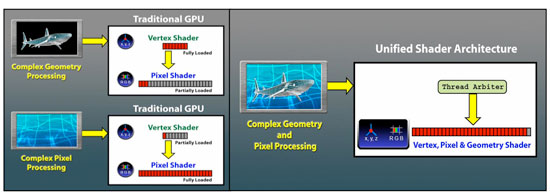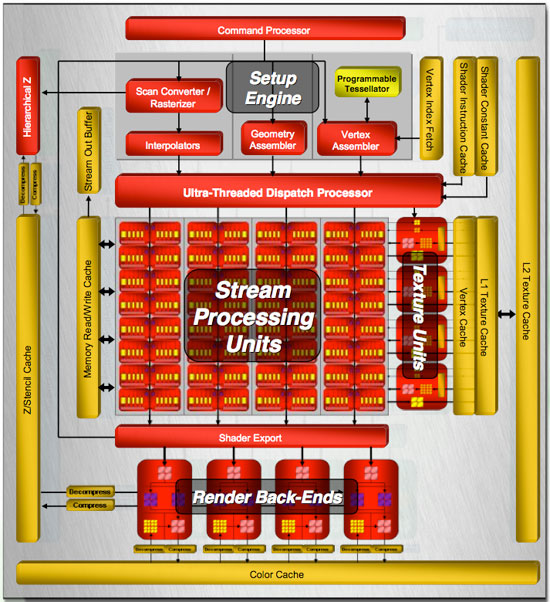ATI Radeon HD 2900 XT: Calling a Spade a Spade
by Derek Wilson on May 14, 2007 12:04 PM EST- Posted in
- GPUs
R600 Overview
From a very high level, we have the same capabilities we saw in the G80, where each step in the pipeline runs on the same hardware. There are a lot of similarities when stepping way back, as the same goals need to be accomplished: data comes into the GPU, gets setup for processing, shader code runs on the data, and the result either heads back up for another pass through the shaders or moves on to be rendered out to the framebuffer.

The obvious points are that R600 is a unified architecture that supports DX10. The set of requirements for DX10 are very firm this time around, so we won't see any variations in feature support on a basic level. AMD and NVIDIA are free to go beyond the DX10 spec, but these features might not be exposed through the Microsoft API without a little tweaking. AMD includes one such feature, a tessellator unit, which we'll talk about more later. For now, let's take a look at the overall layout of R600.

Our first look shows a huge amount of stream processing power: 320 SPs all told. These are a little different than NVIDIA's SPs, and over the next few pages we'll talk about why. Rather than a small number of SPs spread across eight groups, our block diagram shows R600 has a high number of SPs in each of four groups. Each of these four groups is connected to its own texture unit, while they share a connection to shader export hardware and a local read/write cache.
All of this is built on an 80nm TSMC process and uses in the neighborhood of 720 Million transistors. All other R6xx parts will be built on a 65nm processes with many fewer transistors, making them much smaller and more power efficient. Core clock speed is on the order of 740MHz for R600 with memory running at 825MHz.
Memory is slower this time around with higher bandwidth, as R600 implements a 512-bit memory bus. While we're speaking about memory, AMD has revised their Ring Bus architecture for this round, which we'll delve into later. Unfortunately we won't be able to really compare it to NVIDIA's implementation, as they won't go into any detail with us on internal memory buses.
And speaking of things NVIDIA won't go into detail on, AMD was good enough to share very low level details, including information on cache sizes and shader hardware implementation. We will be very happy to spend time talking about this, and hopefully AMD will inspire NVIDIA to start opening up a little more and going deeper into their underlying architecture.
To hit the other hot points, R600 does have some rather interesting unique features to back it up. Aside from including a tessellation unit, they have also included an audio processor on their hardware. This will accept audio streams and send them out over their DVI port through a special converter to integrate audio with a video stream over HDMI. This is unique, as current HDMI converters only work with video. AMD also included a programmable AA resolve feature that allows their driver team to create new ways of filtering subsample data.
R600 also features an independent DMA engine that can handle moving and managing all memory to and from the GPU, whether it's over the PCIe bus or local memory channels. This combined with huge amounts of memory bandwidth should really assist applications that require large amounts of data. With DX10 supporting up to 8k x 8k textures, we are very interested in seeing these limits pushed in future games.
That's enough of a general description to whet your appetite: let's dig down under the surface and find out what makes this thing tick.










86 Comments
View All Comments
Roy2001 - Tuesday, May 15, 2007 - link
The reason is, you have to pay extra $ for a power supply. No, most probably your old PSU won't have enough milk for this baby. I will stick with nVidia in future. My 2 cents.Chaser - Tuesday, May 15, 2007 - link
Such a revealing tech article. Thanks for other sources Tom.
archcommus - Tuesday, May 15, 2007 - link
$300 is the exact price point I shoot for when buying a video card, so that pretty much eliminates AMD right off the bat for me right now. I want to spend more than $200 but $400 is too much. I'm sure they'll fill this void eventually, and how that card will stack up against an 8800 GTS 320 MB is what I'm interested in.H4n53n - Tuesday, May 15, 2007 - link
Interesting enough in some other websites it wins from 8800 gtx in most games,especially the newer ones and comparing the price i would say it's a good deal?I think it's just driver problems,ati has been known for not having a very good driver compared to nvidia but when they fixed it then it'll windragonsqrrl - Thursday, August 25, 2011 - link
lol...fail. In retrospect it's really easy to pick out the EPIC ATI fanboys now.Affectionate-Bed-980 - Tuesday, May 15, 2007 - link
I skimmed this article because I have a final. ATI can't hold a candle to NV at the moment it seems. Now while the 2900XT might have good value, I am correct in saying that ATI has lost the performance crown by a buttload (not even like X1800 vs 7800) but like they're totally slaughtered right?Now I won't go and comment about how the 2900 stacks up against competition in the same price range, but it seems that GTSes can be acquired for cheap.
Did ATI flop big here?
vailr - Monday, May 14, 2007 - link
I'd rather use a mid-range older card that "only" uses ~100 Watts (or less) than pay ~$400 for a card that requires 300 Watts to run. Doesn't AMD care about "Global Warming"?Al Gore would be amazed, alarmed, and astounded !!
Deusfaux - Monday, May 14, 2007 - link
No they dont and that's why the 2600 and 2400 don't existochentay4 - Monday, May 14, 2007 - link
Let me start with this: i always had a nvidia card. ALWAYS.Faster is NOT ALWAYS better. For the most part this is true, for me, it was. One year ago I boght a MSI7600GT. Seemed the best bang for the buck. Since I bought it, I had problems with TVout detection, TVout wrong aspect ratios, broken LCD scaling, lot of game problems, inexistent support (nv forum is a joke) and UNIFIED DRIVER ARQUITECTURE. What a terrible lie! The latest official drivers is 6 months ago!!!
Im really demanding, but i payed enough to demand a 100% working product. Now ATi latest offering has: AVIVO, FULL VIDEO ACC, MONTHLY DRIVER UPDATES, ALL BUGS I NOTICED WITH NVIDIA CARD FIXED, HDMI AND PRICE. I prefer that than a simple product, specially for the money they cost!
I will never buy a nvidia card again. I'm definitely looking forward ATis offering (after the joke that is/was 8600GT/GTS).
Enough rant.
Am I wrong?
Roy2001 - Tuesday, May 15, 2007 - link
Yeah, you are wrong. Spend $400 on a 2900XT and then $150 on a PSU.